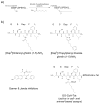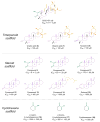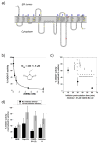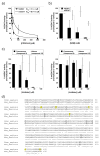Synthetic Triterpenoid Inhibition of Human Ghrelin O-Acyltransferase: The Involvement of a Functionally Required Cysteine Provides Mechanistic Insight into Ghrelin Acylation
- PMID: 28134508
- PMCID: PMC5319884
- DOI: 10.1021/acs.biochem.6b01008
Synthetic Triterpenoid Inhibition of Human Ghrelin O-Acyltransferase: The Involvement of a Functionally Required Cysteine Provides Mechanistic Insight into Ghrelin Acylation
Abstract
The peptide hormone ghrelin plays a key role in regulating hunger and energy balance within the body. Ghrelin signaling presents a promising and unexploited target for development of small molecule therapeutics for treatment of obesity, diabetes, and other health conditions. Inhibition of ghrelin O-acyltransferase (GOAT), which catalyzes an essential octanoylation step in ghrelin maturation, offers a potential avenue for controlling ghrelin signaling. Through screening a small molecule library, we have identified a class of synthetic triterpenoids that efficiently inhibit ghrelin acylation by the human isoform of GOAT (hGOAT). These compounds function as covalent reversible inhibitors of hGOAT, providing the first evidence of the involvement of a nucleophilic cysteine residue in substrate acylation by a MBOAT family acyltransferase. Surprisingly, the mouse form of GOAT does not exhibit susceptibility to cysteine-modifying electrophiles, revealing an important distinction in the activity and behavior between these closely related GOAT isoforms. This study establishes these compounds as potent small molecule inhibitors of ghrelin acylation and provides a foundation for the development of novel hGOAT inhibitors as therapeutics targeting diabetes and obesity.
Conflict of interest statement
J.L.H. and J.D.C. have patent interests in the use of compounds reported herein to target ghrelin signaling and associated health conditions.
Figures







Similar articles
-
Ghrelin octanoylation by ghrelin O-acyltransferase: protein acylation impacting metabolic and neuroendocrine signalling.Open Biol. 2021 Jul;11(7):210080. doi: 10.1098/rsob.210080. Epub 2021 Jul 28. Open Biol. 2021. PMID: 34315274 Free PMC article. Review.
-
Structure-activity analysis of human ghrelin O-acyltransferase reveals chemical determinants of ghrelin selectivity and acyl group recognition.Biochemistry. 2015 Feb 3;54(4):1100-10. doi: 10.1021/bi5010359. Epub 2015 Jan 21. Biochemistry. 2015. PMID: 25562443
-
A fluorescent peptide substrate facilitates investigation of ghrelin recognition and acylation by ghrelin O-acyltransferase.Anal Biochem. 2013 Jun 1;437(1):68-76. doi: 10.1016/j.ab.2013.02.013. Epub 2013 Feb 27. Anal Biochem. 2013. PMID: 23453974
-
Biochemical Assays for Ghrelin Acylation and Inhibition of Ghrelin O-Acyltransferase.Methods Mol Biol. 2019;2009:227-241. doi: 10.1007/978-1-4939-9532-5_18. Methods Mol Biol. 2019. PMID: 31152408
-
Ghrelin O-acyltransferase assays and inhibition.Methods Enzymol. 2012;514:205-28. doi: 10.1016/B978-0-12-381272-8.00013-1. Methods Enzymol. 2012. PMID: 22975055 Free PMC article. Review.
Cited by
-
Combined Computational-Biochemical Approach Offers an Accelerated Path to Membrane Protein Solubilization.J Chem Inf Model. 2023 Nov 27;63(22):7159-7170. doi: 10.1021/acs.jcim.3c00917. Epub 2023 Nov 8. J Chem Inf Model. 2023. PMID: 37939203 Free PMC article.
-
Design, Synthesis, and Evaluation of Inhibitors of Hedgehog Acyltransferase.J Med Chem. 2024 Jan 25;67(2):1061-1078. doi: 10.1021/acs.jmedchem.3c01363. Epub 2024 Jan 10. J Med Chem. 2024. PMID: 38198226 Free PMC article.
-
Discovery of novel inhibitors of ghrelin O-acyltransferase enzyme: an in-silico approach.Res Pharm Sci. 2022 Sep 8;17(5):540-557. doi: 10.4103/1735-5362.355212. eCollection 2022 Oct. Res Pharm Sci. 2022. PMID: 36386482 Free PMC article.
-
Recent progress in the discovery of ghrelin O-acyltransferase (GOAT) inhibitors.RSC Med Chem. 2020 Sep 4;11(10):1136-1144. doi: 10.1039/d0md00210k. eCollection 2020 Oct 1. RSC Med Chem. 2020. PMID: 33479618 Free PMC article. Review.
-
Ghrelin octanoylation by ghrelin O-acyltransferase: protein acylation impacting metabolic and neuroendocrine signalling.Open Biol. 2021 Jul;11(7):210080. doi: 10.1098/rsob.210080. Epub 2021 Jul 28. Open Biol. 2021. PMID: 34315274 Free PMC article. Review.
References
-
- Centers for Disease Control and Prevention. National diabetes fact sheet: National estimates and general information on diabetes and prediabetes in the united states, 2011. U.S. Department of Health and Human Services; 2011.
-
- International Diabetes Federation. Idf diabetes atlas. 6. Brussels, Belgium: 2013.
-
- Kojima M, Hosoda H, Date Y, Nakazato M, Matsuo H, Kangawa K. Ghrelin is a growth-hormone-releasing acylated peptide from stomach. Nature. 1999;402:656–660. - PubMed
-
- Tschop M, Smiley DL, Heiman ML. Ghrelin induces adiposity in rodents. Nature. 2000;407:908–913. - PubMed
-
- Kojima M, Kangawa K. Structure and function of ghrelin. Results Probl Cell Differ. 2008;46:89–115. - PubMed
MeSH terms
Substances
Grants and funding
LinkOut - more resources
Full Text Sources
Other Literature Sources
Chemical Information
Molecular Biology Databases

